
OFFICIAL
AFP Corporate Writing
Style Guide / September 2024
Table of contents
Introduction
3
1.0 Accessible and inclusive content
4
1.1 Accessible content
4
1.2 Literacy and access
5
1.3 Inclusive language
5
2.0 Language guide
11
2.1 Tone of voice
11
2.2 Using everyday words (plain English)
11
ACT 1982
2.3 Active vs passive language
13
3.0 Grammar and style
14
3.1 Abbreviations
14
3.2 Acronyms (and initialisms)
15
INFORMATION
3.3 Ampersands (&)
16
DE-CLASSIFIED AND RELEASED
3.4 Apostrophes
16
3.5 Attributions
16
3.6 Capital letters
17
3.7 Col ective nouns
18
3.8 Commas
18
BY THE AUSTRALIAN FEDERAL POLICE
3.9 Compound adjectives
19
3.10 Contractions
19
THIS DOCUMENT IS
3.11 Captions and credits
20
UNDER THE FREEDOM OF
3.12 Dashes (en/em) and hyphens
20
3.13 Date, time and time zones
22
3.14 Ellipsis points ( … )
23
3.15 Font and style
24
3.16 Italics
24
3.17 Hyperlinks
24
3.18 Legislation
25
AFP / COMMUNICATIONS AND CUSTOMS
1
LEX 3256
OFFICIAL
FOLIO 2
OFFICIAL
AFP Corporate Writing
Style Guide / September 2024
3.19 Lists (bullet points)
25
3.20 Numerical representation
27
3.21 Quotation marks, omitting direct speech, and paraphrasing
29
3.22 Web and email addresses
30
3.23 Telephone numbers
30
3.24 Writing for the web
31
ACT 1982
s47E(d)
INFORMATION
DE-CLASSIFIED AND RELEASED
5.0 Resources
40
BY THE AUSTRALIAN FEDERAL POLICE
THIS DOCUMENT IS
UNDER THE FREEDOM OF
Document details
Originating area
Enterprise Communications
Date produced
June 2023
Date last reviewed
September 2024
Cleared by
Manager Communications and Customs
AFP / COMMUNICATIONS AND CUSTOMS
2
LEX 3256
OFFICIAL
FOLIO 3
OFFICIAL
AFP Corporate Writing
Style Guide / September 2024
Introduction
The
AFP Corporate Writing Style Guide maintains a consistent style of written and spoken
communication in formal and day-to-day corporate communication products on behalf of the
agency.
The guide has 5 chapters
1. Accessible and inclusive content
2. Language guide
3. Grammar and style
4. Policing considerations
5. Resources
Guidance should be applied to al communication products and formal documents, including briefs
and corporate reporting documents. Not al style recommendations are relevant for media relea
ACT 1982 ses
or court documents which fol ow traditional news writing techniques.
The
AFP Corporate Writing Style Guide is
consistent with the
Australian Government Style Manual
and has been developed by Enterprise Communications, in partnership with ACT Policing and
Government Relations. Its spel ing is consistent with the
Macquarie Dictionary which is the
preferred Australian English dictionary for the agency Where relevant, Australian New Zealand
Policing Advisory Agency (ANZPAA) protocols have been incorporated.
INFORMATION
Reference is made where AFP style differs from the
Australian Government Style Manual.
DE-CLASSIFIED AND RELEASED
Contact
s47E(d)
@afp.gov au for queries.
BY THE AUSTRALIAN FEDERAL POLICE
THIS DOCUMENT IS
UNDER THE FREEDOM OF
AFP / COMMUNICATIONS AND CUSTOMS
3
LEX 3256
OFFICIAL
FOLIO 4
OFFICIAL
AFP Corporate Writing
Style Guide / September 2024
1.0 Accessible and inclusive content
People can experience ongoing, temporary or situational barriers to access the information they
need. We make al information available to them by designing accessible and inclusive content.
The Australian Government's aim is that al government services are digital first. This aim is
described in the
Government Digital Strategy.
Australian Government digital services must be usable and accessible – a requirement under
the
Digital Service Standard.
1.1 Accessible content
The
Web Content Accessibility Guidelines 2.2 (WCAG) set the accessibility standard for Australian
Government content. It addresses how to meet the specific needs of people with disability and
should be used for al communication products.
ACT 1982
The WCAG outlines 4 accessibility principles to ensure content is:
1. perceivable
2. operable
3. understandable
4. robust.
INFORMATION
Each principle provides practical ways to ensure content meets the users’ needs, for example:
DE-CLASSIFIED AND RELEASED
▪ text alternatives for images
▪ adaptable formatting to avoid the user losing information or structure
▪ using inclusive, everyday language.
Additional resources include:
▪ The
Web Content Accessibility Guidelines which provides detailed information on how to
implement accessibility on in relation to writing and editing.
▪ The
Australian Government Style Manual which outlines the basics for accessible and inclusive
BY THE AUSTRALIAN FEDERAL POLICE
content.
THIS DOCUMENT IS
1.1.2 Inclusive content
UNDER THE FREEDOM OF
Inclusive content recognises Australia’s diversity and the diversity of technology we use to engage
online.
For example, inclusive content accommodates:
▪ cultural and linguistic diversity among users
▪ diversity of abilities among users
▪ how users interact with technology in different contexts.
AFP / COMMUNICATIONS AND CUSTOMS
4
LEX 3256
OFFICIAL
FOLIO 5










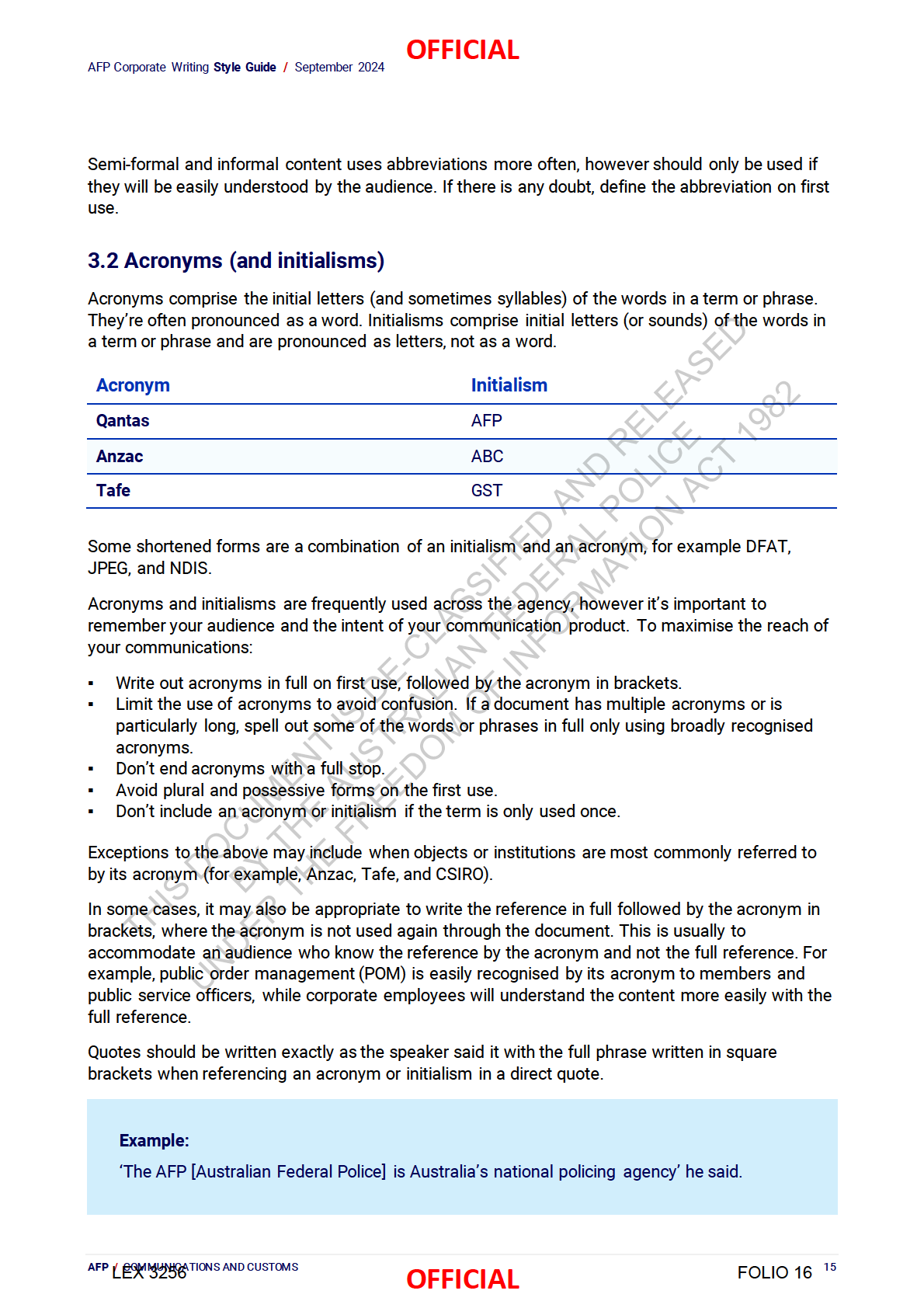


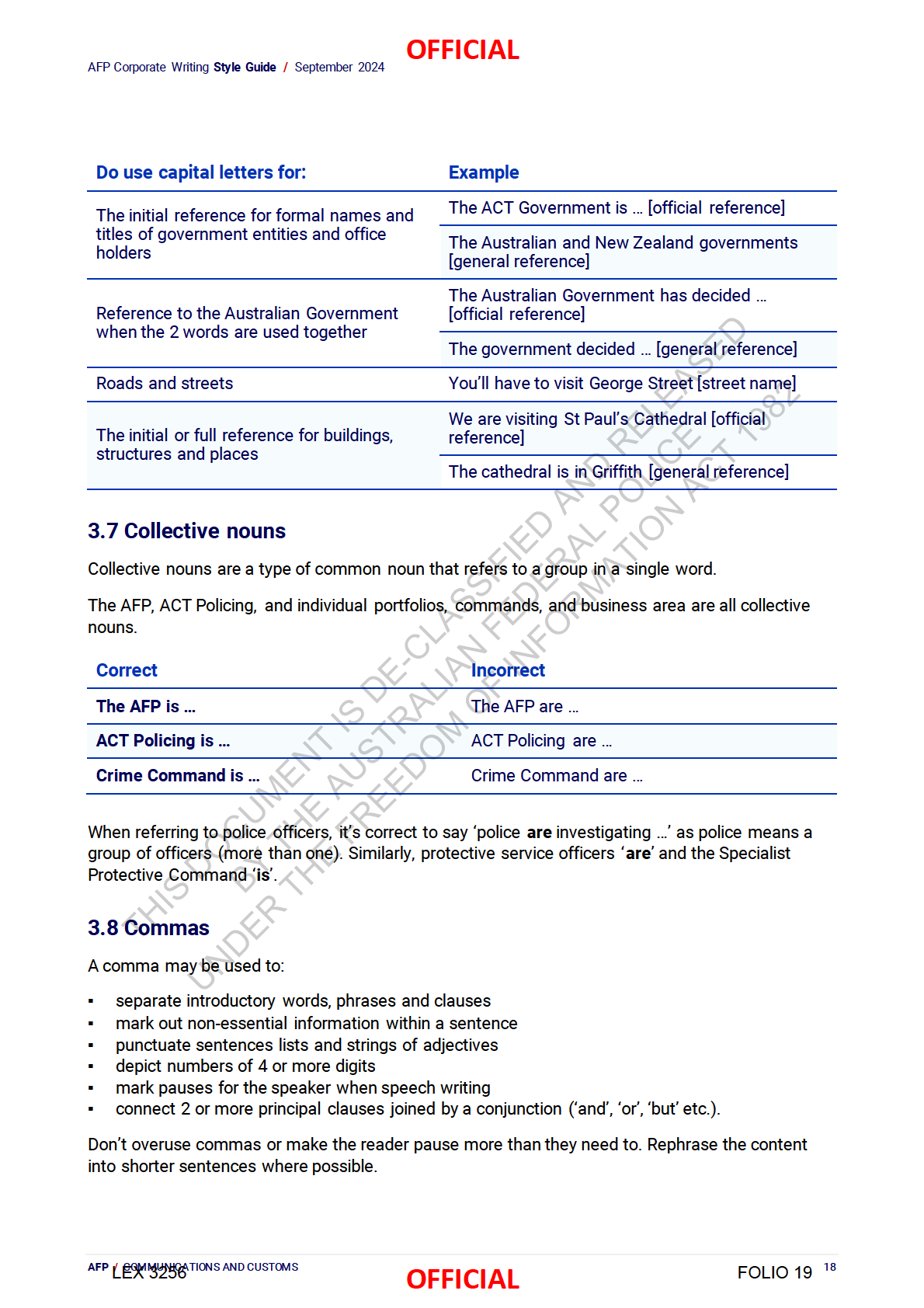





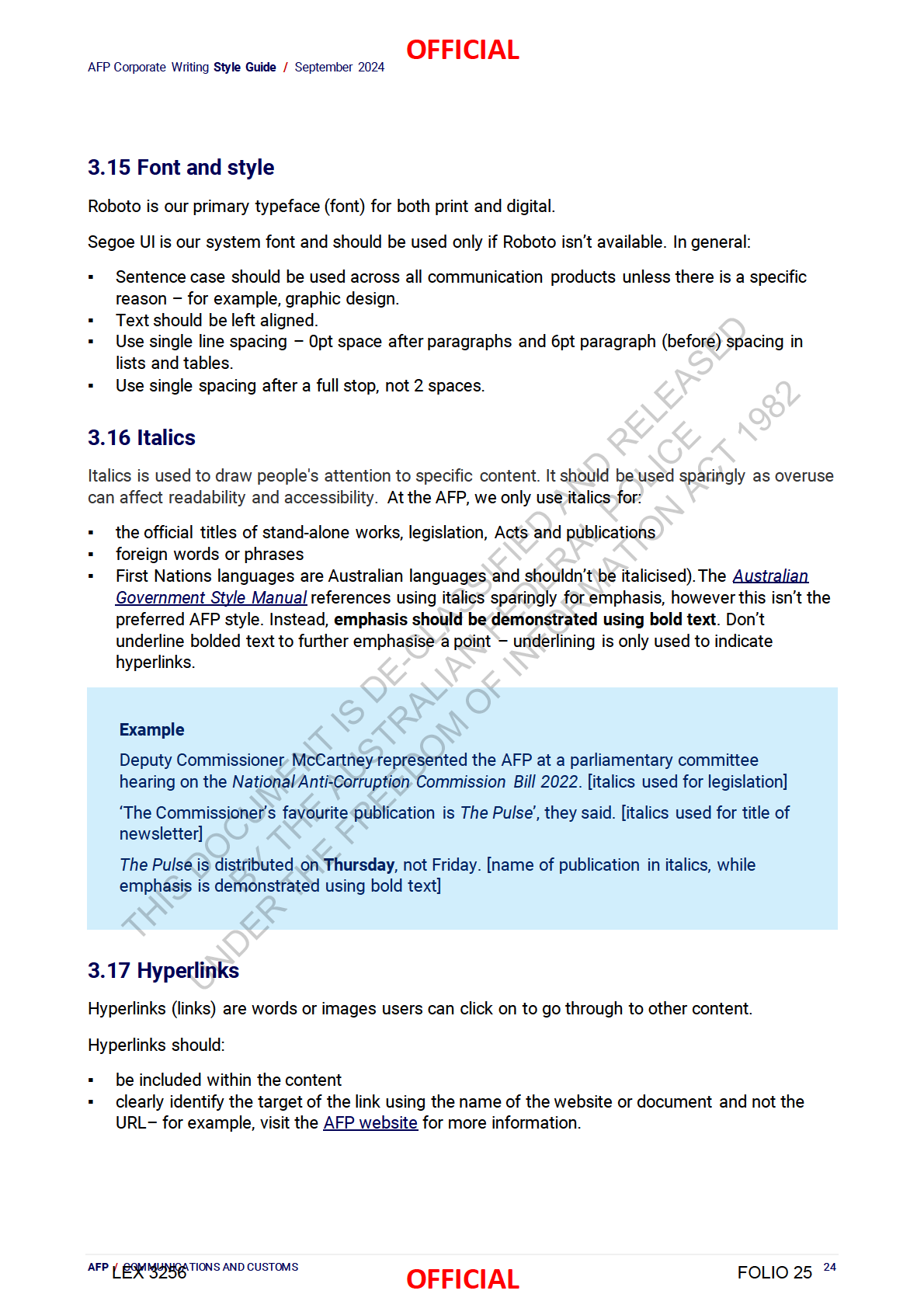

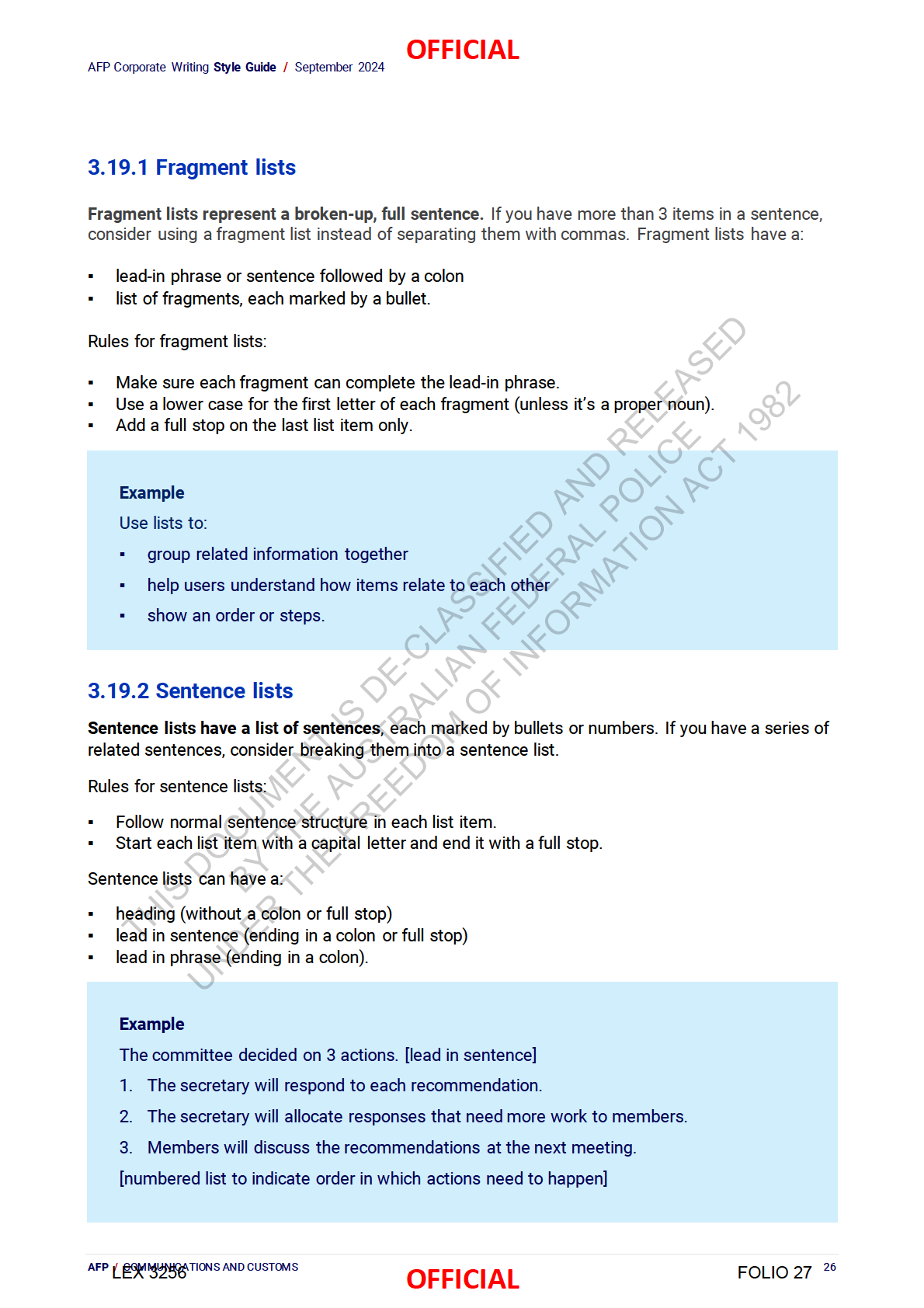
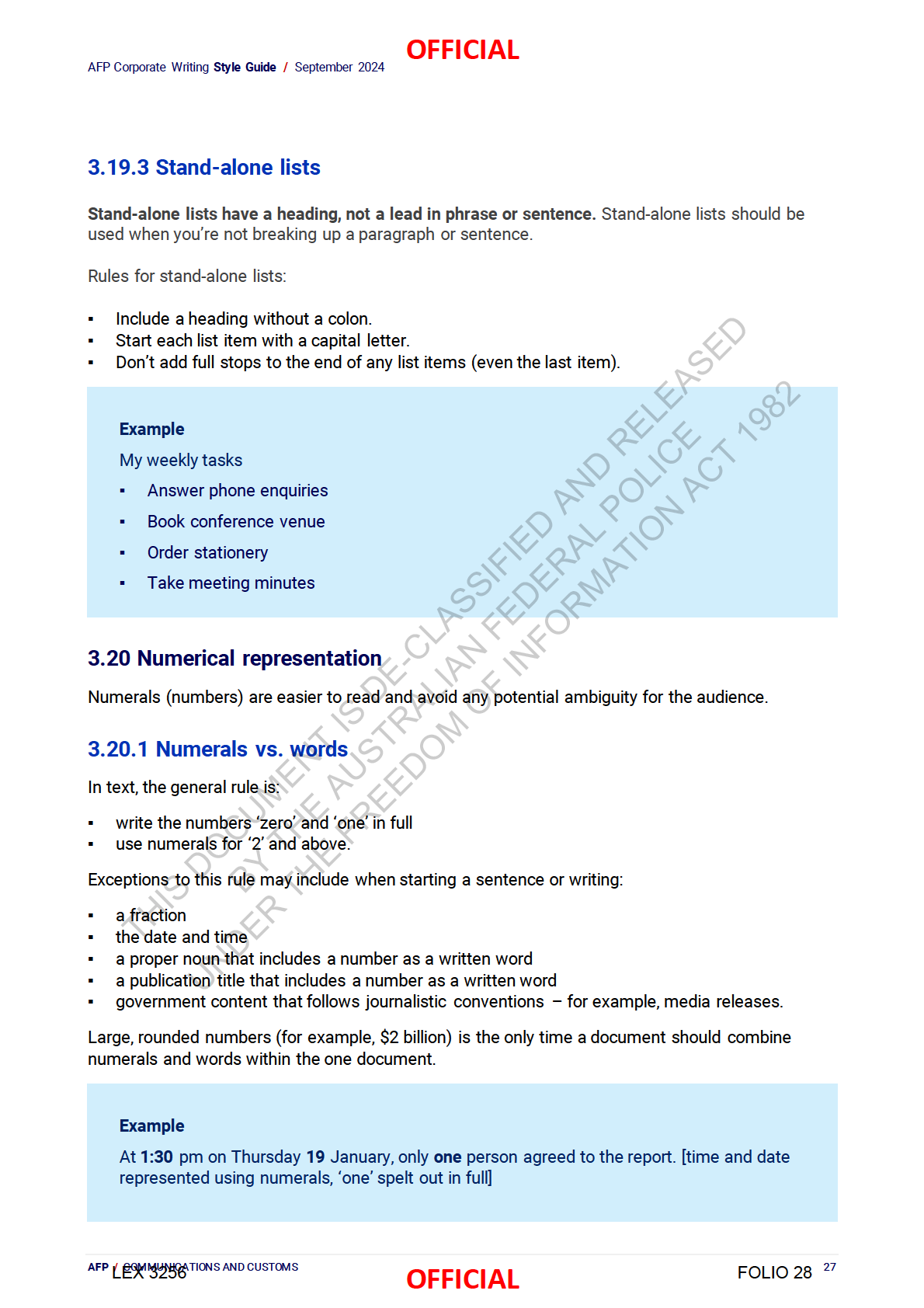


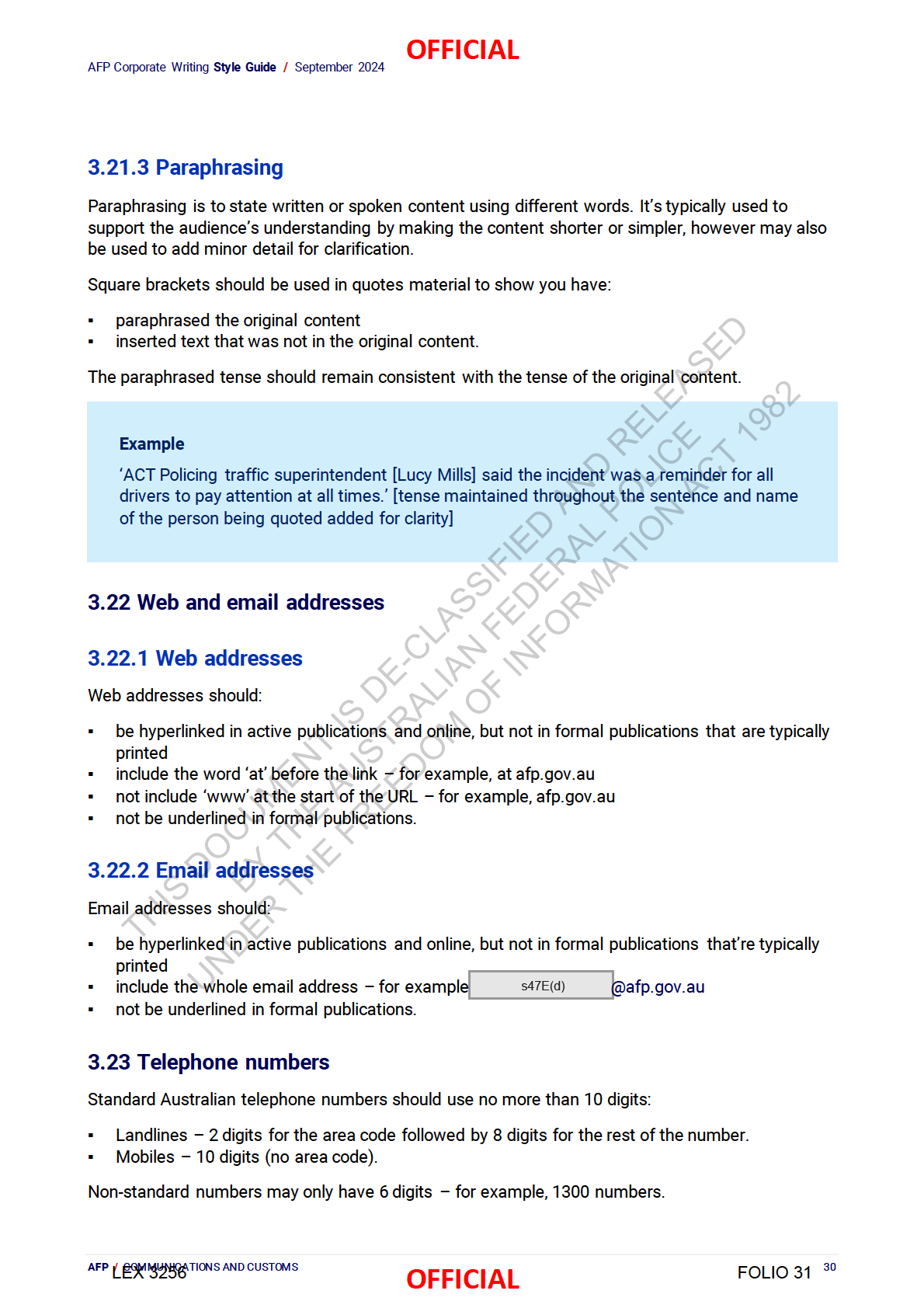
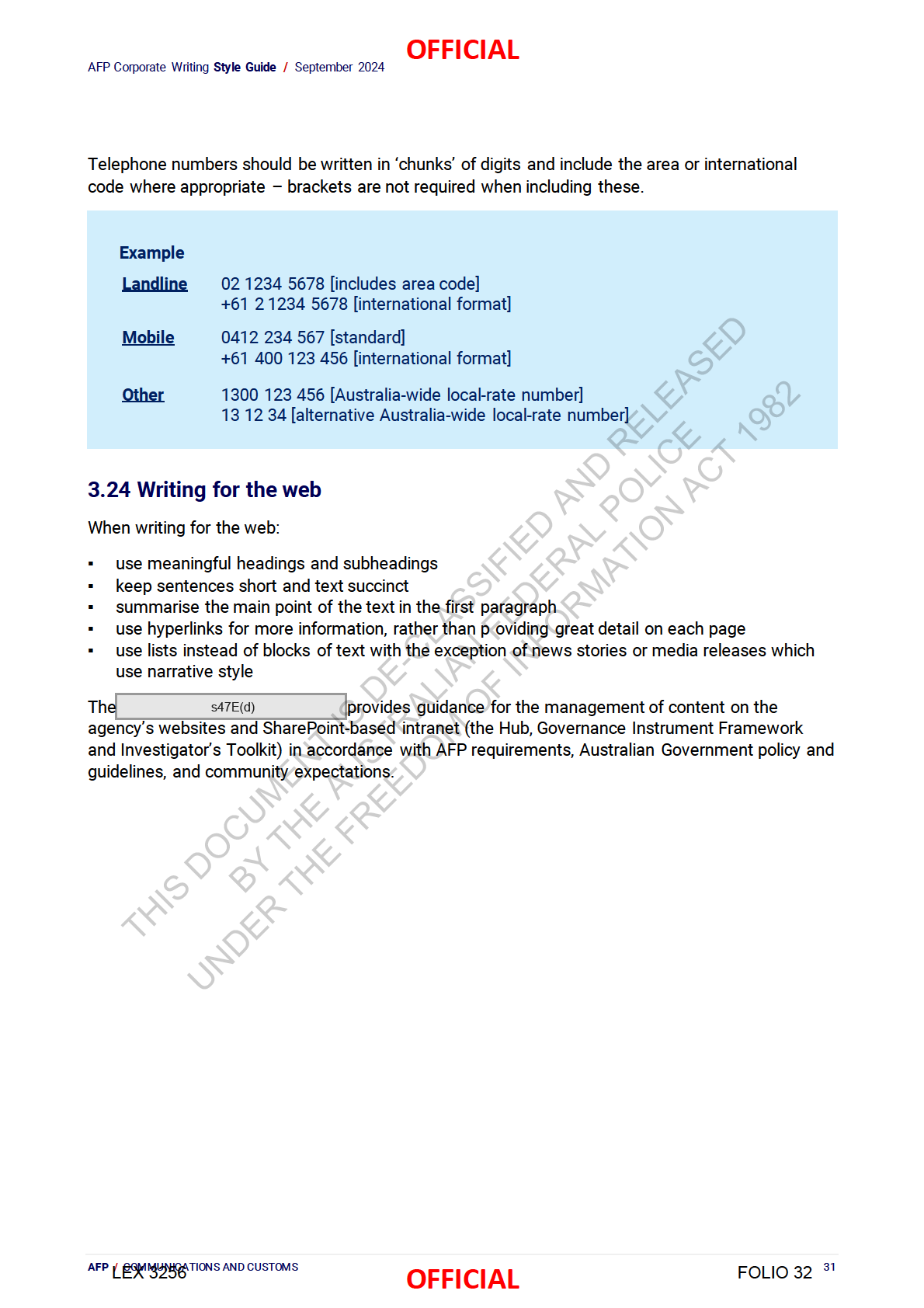
Pages 33 through 40 redacted for the following reasons:
- - - - - - - - - - - - - - - - - - - - - - - - - - - -
s47E(d)
ACT 1982
INFORMATION
BY THE AUSTRALIAN FEDERAL POLICE
THIS DOCUMENT IS DE-CLASSIFIED AND RELEASED
UNDER THE FREEDOM OF
OFFICIAL
AFP Corporate Writing
Style Guide / September 2024
5.0 Resources
▪
Australian Government Style Manual
▪
PWDA Language Guide: A guide to language about disability
▪
Australian Human Rights Commission
▪
Mindframe
▪
The Macquarie Dictionary and Thesaurus
▪
Web Content Accessibility Guidelines (WCAG) 2.1
ACT 1982
INFORMATION
BY THE AUSTRALIAN FEDERAL POLICE
THIS DOCUMENT IS DE-CLASSIFIED AND RELEASED
UNDER THE FREEDOM OF
AFP / COMMUNICATIONS AND CUSTOMS
40
LEX 3256
OFFICIAL
FOLIO 41
Pages 42 through 83 redacted for the following reasons:
- - - - - - - - - - - - - - - - - - - - - - - - - - - -
s47E(d)
ACT 1982
INFORMATION
BY THE AUSTRALIAN FEDERAL POLICE
THIS DOCUMENT IS DE-CLASSIFIED AND RELEASED
UNDER THE FREEDOM OF



























